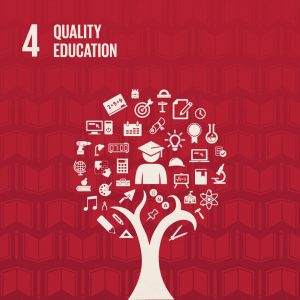By Lisa Kensler.
Sustainable Development Goal 4 calls for ensuring inclusive and equitable quality education and promoting lifelong learning opportunities for all. The targets speak to addressing every aspect of education from equity and teacher quality to facilities and curricula. The systemic challenges facing education and those of us striving to improve it – whether locally and/or globally – are dynamic and interdependent. There is no single solution that will magically correct historic and entrenched patterns of injustice, alienation, and ineffectiveness. We need expansive whole system solutions. Whole school sustainability offers one such approach. At the core of whole school sustainability is a fundamental shift in system design from industrialized models of hierarchical silos to living system models of inclusive interdependencies.
Where industrialized education models are infused with policies and curricula that reinforce and perpetuate hierarchical views of humanity and stark separation from nature, whole school sustainability models center equity and connection with each other and nature. Principles of democracy and ecology inform whole school sustainability. Ecological principles when operating without constraint govern healthy natural systems, of which we are a part. Democratic principles govern healthy social systems. Human health and wellbeing depend on both healthy ecological systems and healthy social systems. Whole school sustainability is the aspiration of sustainability applied to every aspect of education, transforming where, how, and why we facilitate learning among children, adults, and communities.
Where we learn matters. Whole school sustainability calls for school buildings and grounds to reflect environmentally responsible design and management, with aims for net zero and even restorative impacts alongside nature-inspired approaches for human wellbeing. These facilities and their management teams become valued members of the teaching team – inviting student and even community engagement in learning about sustainable design. With whole school sustainability at the helm, schools become central drivers for innovative solutions in their communities – contributing to present climate resilience and adaptation needs while also raising a generation of sustainability natives.
Sustainability natives have a deep understanding of social and ecological interdependencies that inform their capacity for developing innovative solutions across every layer of life from personal to professional practice. If sustainability natives are to graduate from our schools, then not only where they learn, but how they learn must transform. Siloed content taught in isolation of real-world circumstances and challenges must become a past practice. Whole school sustainability offers children the opportunity to learn literacy and numeracy in the context of discovering how their curiosity and passions might serve aims for a healthy, vibrant future – theirs, their community’s, and our planet’s. This approach to teaching and learning is grounded in place, in their local socio-ecological context, and invites engagement in addressing local to global problems through classroom projects artfully designed and facilitated by teachers who see themselves not only as educators but also co-learners contributing to a better future. This approach to learning brings math, reading, and writing together in service to better understanding history, social studies, and science. Sustainability natives understand that social justice issues are inseparable from environmental issues (see Hop Hopkin’s article) and require innovative solutions that integrate traditionally isolated subject areas.
Where we learn matters. How we learn matters. And why we learn matters. Whole school sustainability ignites the why of education; it brings socio-ecological crises facing humanity into classrooms for the purpose of understanding their systemic nature, engaging deep learning, and empowering learners to enact innovative solutions now and into the future. Children around the world are eager for this approach to relevant, meaningful, and rigorous learning with a powerful purpose. As Goleman and Senge (2014) explained in their book The Triple Focus: A New Approach to Education,
We must remember that for the first time in human history, children grow up today in the world. By the age of seven or eight, kids are quite aware of the larger environmental and social problems in the world. They can connect the dots. They know these issues will shape the world in which they will live. What they are most lacking is a sense that their schools also know, and can help them prepare to be able to do something about these issues. (p. 84)
Whole school sustainability, as a high leverage solution, has the potential to address every major challenge facing humanity by engaging teachers and students in learning into local, deeply place-based solutions. And at the very same time improving the quality of education by informing the where, how, and why of learning. The challenges facing humanity – social and economic inequities, climate change, biodiversity loss, to name just a few – demand our attention, time, and innovation. We must learn to live differently with each other on this planet of ours and what better place than in schools designed for meeting these challenges as opportunities.
A brief blog post is just the beginning! Are you interested in exploring more of these ideas? The Center for Green Schools at the U. S. Green Building Council offers an extraordinary list of free resources. The Green School Catalyst Quarterly, published by the Green Schools National Network, is a free, online publication that includes exemplars of whole school sustainability in action. And, my co-author, Cynthia Uline, and I have written two books. Our first book, published by Routledge in 2017, Leadership for Green Schools: Sustainability for Our Children, Our Communities, and Our Planet, presents an accessible research-based argument for whole school sustainability. And our second book, published with Routledge in 2021, A Practical Guide to Leading Green Schools: Partnering with Nature to Create Vibrant, Flourishing, Sustainable Schools, is just that – a practical guide for how to transform a more traditional school into a school in service to the 22nd century rather than the 20th century!
Post contributed by Lisa A. W. Kensler, Emily R. and Gerald S. Leischuck Endowed Professor , Educational Leadership
Learn about the SDGs & AU and our contributions related to this post.




